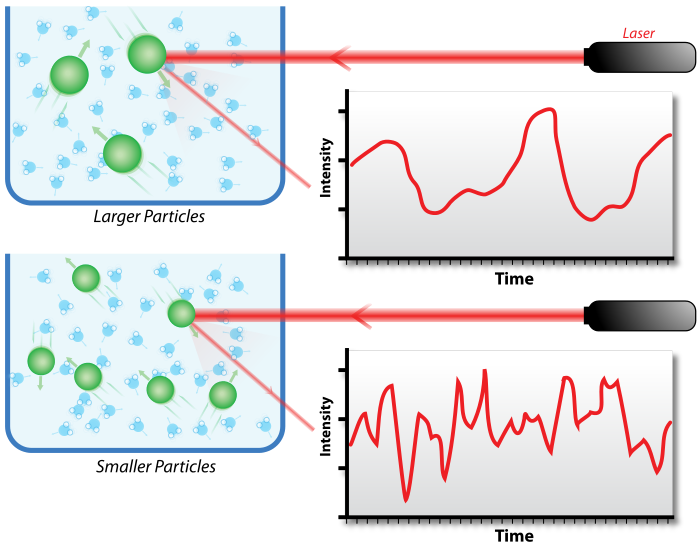Dynamic Light Scattering (DLS): Measuring Nanoparticle Size and Distribution
What is Dynamic Light Scattering?
Dynamic light scattering (DLS), also known as photon correlation spectroscopy or quasi-elastic light scattering, is a technique used to determine the size distribution profile of small particles in suspension or polymers in solution. It can be used to analyze particles with sizes ranging from a few nanometers to several microns.

How Does DLS Work?
DLS measures the Brownian motion of particles and relates this to the size of the particles. Brownian motion is the random movement of particles due to the bombardment by the solvent molecules that surround them. The larger the particle, the slower the Brownian motion.
In a DLS experiment, a laser illuminates the sample, and the scattered light is detected at a known scattering angle by a fast photon detector. The intensity of the scattered light fluctuates over time due to the Brownian motion of the particles. By analyzing these intensity fluctuations, the diffusion coefficient of the particles can be determined, which can then be used to calculate the hydrodynamic diameter of the particles using the Stokes-Einstein equation.
Key Concepts in DLS
- Autocorrelation Function: The autocorrelation function quantifies the similarity between the scattered light intensity at different time intervals. It decays exponentially with time, and the rate of decay is related to the diffusion coefficient of the particles.
- Hydrodynamic Diameter: The hydrodynamic diameter is the diameter of a sphere that has the same translational diffusion coefficient as the particle being measured. It is influenced by the size, shape, and surface structure of the particle, as well as the ionic strength and viscosity of the dispersing medium.
- Polydispersity Index (PDI): The PDI is a measure of the breadth of the size distribution. It ranges from 0 to 1, with lower values indicating a more monodisperse sample and higher values suggesting a broader size distribution or multiple particle populations.
Advantages and Limitations of DLS
DLS has several advantages over other particle sizing techniques:
- It is a non-invasive and non-destructive method, requiring minimal sample preparation.
- It can measure particles in their native environment, including aqueous solutions and organic solvents.
- It provides a rapid and statistically robust analysis, with measurement times typically in the range of seconds to minutes.
However, DLS also has some limitations:
- It is sensitive to the presence of large particles or aggregates, which can dominate the scattering signal and mask the presence of smaller particles.
- It assumes spherical particles and may not provide accurate size information for non-spherical or highly polydisperse samples.
- It does not provide information about the chemical composition or structure of the particles.
Applications of DLS
DLS is widely used in various fields for particle size and stability analysis:
- Nanomedicine: DLS is used to characterize the size and polydispersity of drug delivery systems, such as liposomes, polymeric nanoparticles, and protein conjugates.
- Colloid Science: DLS is employed to study the stability and aggregation behavior of colloidal dispersions, including emulsions, suspensions, and foams.
- Protein Characterization: DLS can provide information about the size, homogeneity, and aggregation state of proteins in solution, which is essential for understanding their structure and function.
- Environmental Monitoring: DLS is used to analyze the size distribution of particulate matter in water and air samples, helping to assess the presence of pollutants and their potential environmental impact.
Conclusion
Dynamic light scattering is a powerful and versatile technique for measuring the size and distribution of nanoparticles and polymers in solution. By providing rapid and non-invasive analysis, DLS has become an essential tool in various fields, from nanomedicine and colloid science to protein characterization and environmental monitoring. As nanotechnology continues to advance, DLS will likely play an increasingly important role in the development and quality control of nanomaterials and nanodevices.
Further Reading
Biophysical Reviews, Dynamic light scattering: a practical guide and applications in biomedical sciences
Radiation in Bioanalysis, Dynamic Light Scattering (DLS) – Principles, Perspectives, Applications to Biological Samples
